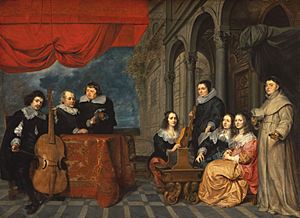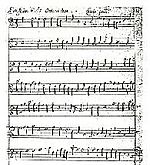Leonora Duarte facts for kids
Leonora Duarte (1610 – 1678?) was a talented Flemish composer and musician. She was born in Antwerp, which is now in Belgium. Her family was very wealthy and came from Portugal. They were Jewish but had to pretend to be Catholic to stay safe. This was because of a time called the Inquisition, when people were punished for their beliefs. Leonora was baptized on July 28, 1610.
Leonora was one of six children in the Duarte family, who were well-known for their love of music. She wrote seven pieces called sinfonias. These are thought to be the earliest music written for the viol by a woman in the 1600s.
The Duarte family home was a famous place for music. Many important people from different countries visited them. This included Constantijn Huygens, a very influential Dutch writer and musician. Leonora wrote music for a group of viols, which are instruments similar to cellos. Her seven surviving sinfonias are for five viols playing together.
Her Family
The Duarte family in Antwerp were rich jewelers and diamond merchants. They were originally from Portugal and were Jewish, but they had to hide their faith. They moved to Antwerp to escape danger from the Inquisition. Leonora's parents were Gaspar Duarte and Catharina Rodrigues. She had three sisters and two brothers.
Her father, Gaspar, and her mother, Catharina, were both trained in music. Gaspar was also a very successful diamond merchant. He was friends with famous harpsichord makers like Ruckers. The Duarte family home was a well-known center for music and art. Leonora's father and brother, Diego, often wrote letters to Constantijn Huygens. These letters show that they knew many important people in the Netherlands and England. Famous visitors included Nicholas Lanier and Anne and Joseph de la Barre.
About Her Life
Leonora Duarte was born in Antwerp. Her family were important merchants and art collectors. They were friends with famous artists and instrument makers. Even though her family had to hide their Jewish faith, they were very successful. They were also great supporters of art and culture.
Leonora received an excellent music education. She learned to play the viol, virginals (a type of harpsichord), and lute. She also had lessons in composing music. The musical evenings at her family home became famous. Many traveling diplomats and writers would visit. These guests included Constantijn Huygens and the composer Nicholas Lanier. The Duarte family was known for welcoming guests and performing music together.
As a Composer
As a young composer, Leonora Duarte wrote seven short pieces for five viols. These pieces are called 'Symphonies' or sinfonias. They are written in a style popular in England during the early 1600s. Her brother, Diego Duarte, also set poems to music, but none of his works have survived.
Leonora Duarte was never asked to write music for a church or a royal court. But she was very special in her musical family because of her talent for composing. Her father, Gaspar, probably wrote the titles for each sinfonia. We don't know who copied the music down. It's possible Leonora copied her own works, as women often did this.
Leonora was able to combine her natural talent with new ideas from Italian and French music. This was because so many visitors from all over Europe came to the Duarte house. Historical records show that the Duarte family had important connections with Constantijn Huygens. They also knew Dirk Sweelinck, whose father was a famous Dutch composer.
Leonora's seven sinfonias show how Baroque music was created and performed at home. This is where her music would have first been heard.
The Duarte house was torn down in the 1800s. However, you can visit the house of their neighbors, the Snijders & Rockox House. It is now a museum with a music room. It has old instruments and sheet music, including some from Leonora. The Duarte family and their neighbors often shared music.
Her Death
We don't know the exact month or year Leonora Duarte died, but it was likely around 1678. Leonora was one of three Duarte daughters who died from the plagues in Antwerp. City records support the year of her death.
Her brother Diego died in 1691 without children. This meant the Duarte family branch in Antwerp came to an end.
See also
 In Spanish: Leonora Duarte para niños
In Spanish: Leonora Duarte para niños



